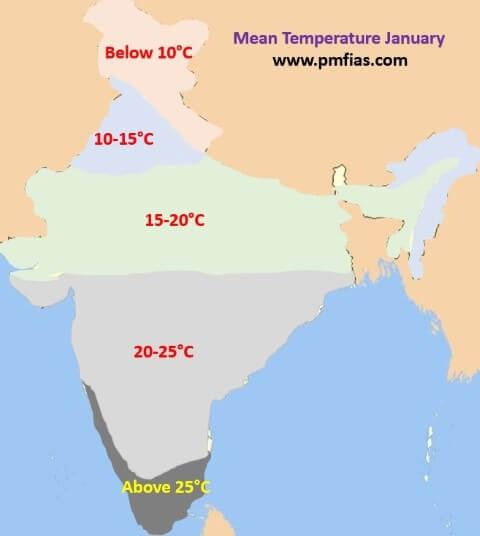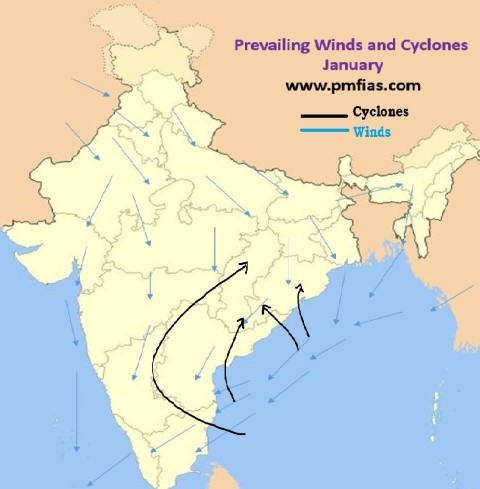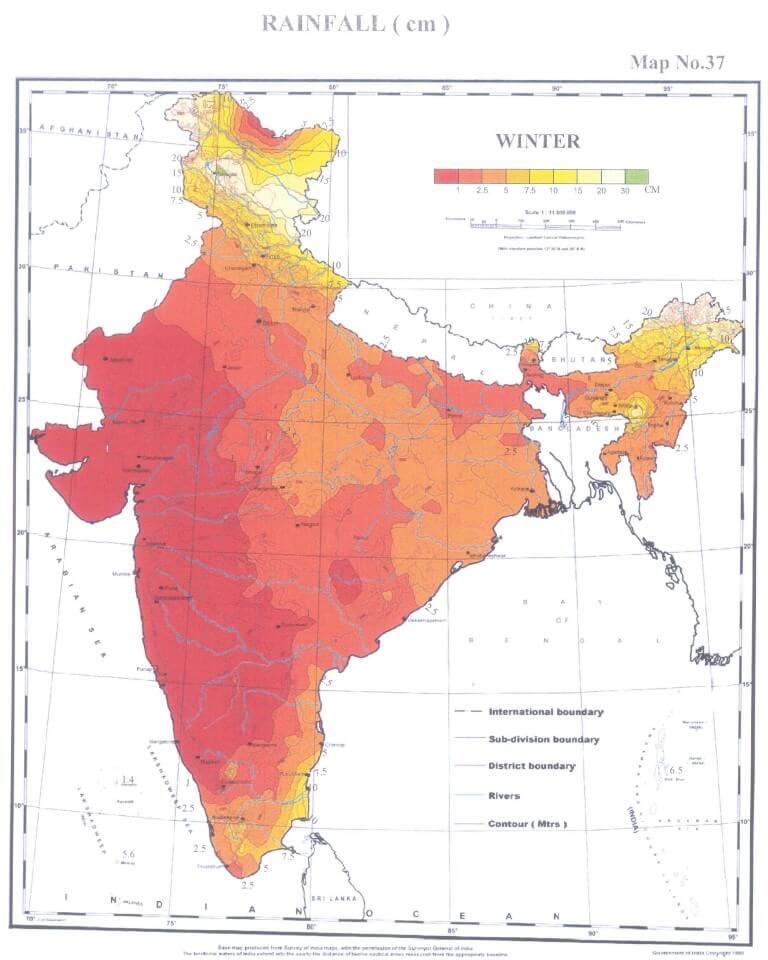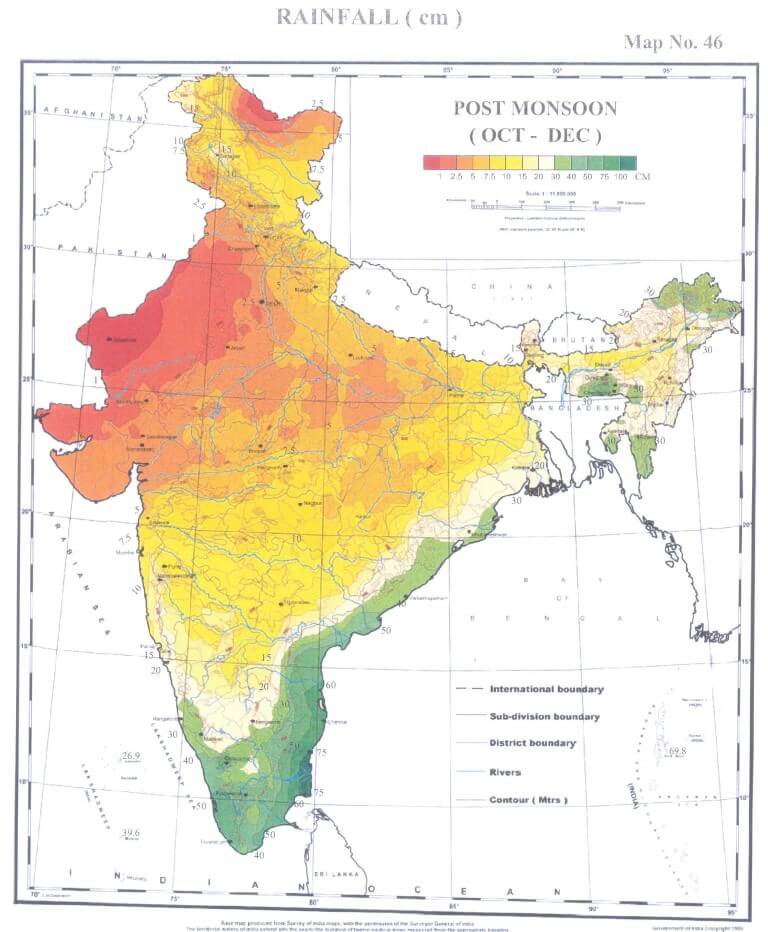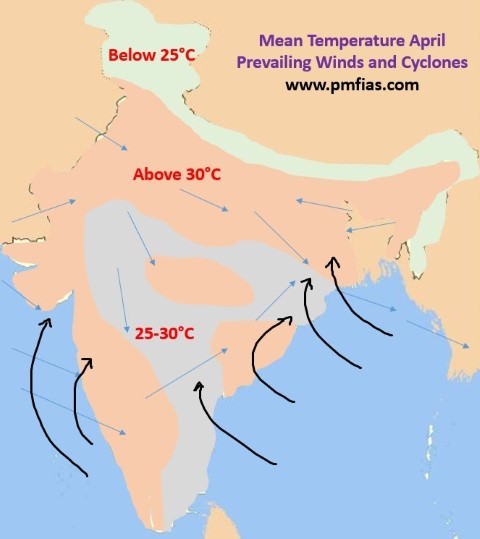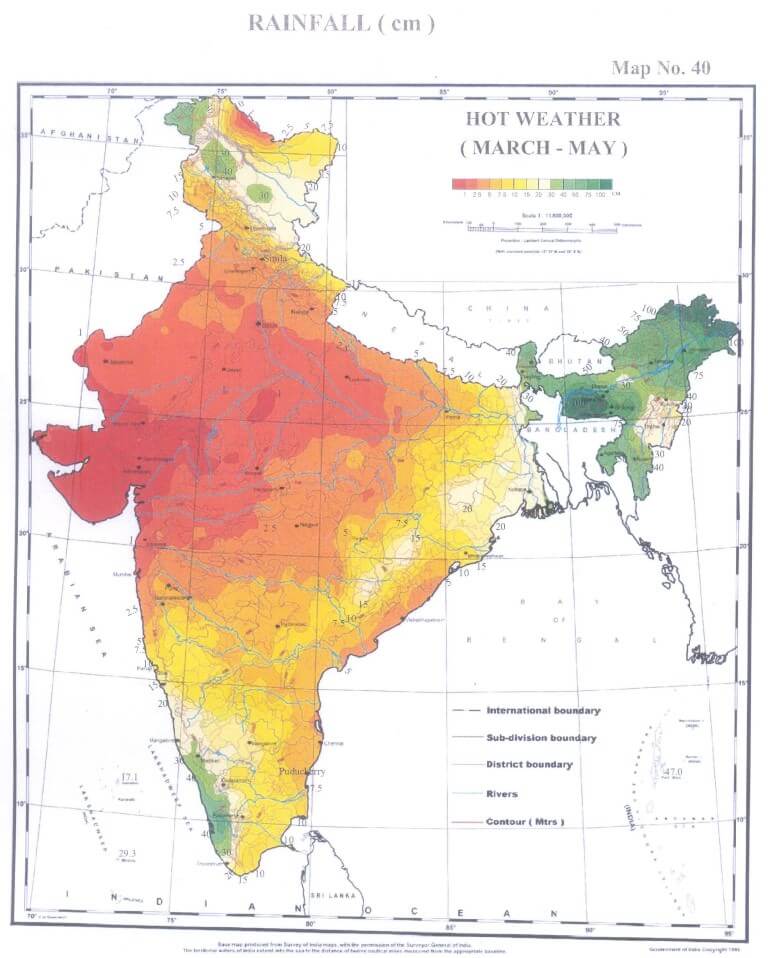Indian Climate: South West Monsoon Season
Table of Contents
South West Monsoon Season – South West Monsoons – Arabian Sea branch & Bay of Bengal branch, Break in South West Monsoons, Advance & Withdrawal.
Isoline, Isobar, Isotherm & Isohyet
- ISOLINE: imaginary lines joining regions with equal rainfall or any other parameter.
- ISOBAR: imaginary lines joining regions with equal pressure.
- ISOTHERM: imaginary lines joining regions with equal temperature.
- ISOHYET: imaginary lines joining regions with equal rainfall.
Rainy Season – South West Monsoon Season
- South West Monsoon Season – June to mid-September.
- South West Monsoon Season is also known as hot-wet season.
- Sudden onset is the important feature of South West Monsoons.
- With the onset of monsoons, temperature falls drastically and humidity levels rise.
Temperature during South West Monsoon Season
- Sudden onset of South West Monsoons leads to significant fall in temperature [3° to 6°C].
- The temperature remains less uniform throughout the rainy season.
- The temperature rises in September with the cease of south-west monsoons.
- There is rise in temperature whenever there is break in the monsoons.
- The diurnal range of temperature is small due to clouds and rains.
- The highest temperatures are experienced at places west of the Aravali [38° to 40°C]. This is due to lack of clouds and hot continental air masses.
- Other parts of Northwest India also have temperatures above 30°C.
- The temperatures are quite low over the Western Ghats due to heavy rainfall.
- The coastal areas of Tamil Nadu and adjoining parts of Andhra Pradesh have temperatures above 30°C as they receive little rainfall during this season.
Pressure and Winds During South West Monsoon Season
- Low pressure conditions prevail over northwest India due to high temperature.
- ITCZ (monsoon trough) lies along the Ganga plain. There are frequent changes in its location depending upon the weather conditions.
- The atmospheric pressure increases steadily southwards.
- Over the peninsular region, due to pressure gradient between north and south, winds blow in a southwest to northeast direction from Arabian sea and Bay of Bengal.
- Their direction undergoes a change in Indo-Gangetic plain where they move from east to west.
Rainfall During South West Monsoon Season
- Three fourths of the total annual rainfall is received during this season.
- The average rainfall over the plains of India in this season is about 87 per cent.
- Normal date of the arrival of the monsoon is 20th May in Andaman and Nicobar Islands.
- The advance of the monsoon is much faster in the Bay of Bengal than in the Arabian Sea.
- The normal date of onset of the southwest monsoon over Kerala i.e. the first place of entry in the mainland of India is 1st June.
- The monsoons advance quickly accompanied with a lot of thunder, lightning and heavy downpour. This sudden onset of rain is termed as monsoon burst.
- Sometimes monsoons are delayed or they come much earlier than normal.
- Normally the onset occurs between 29th May and 7th June.
- The earliest onset was on 11th May in 1918 and 1955, while the most delayed onset was on 18th June in 1972.
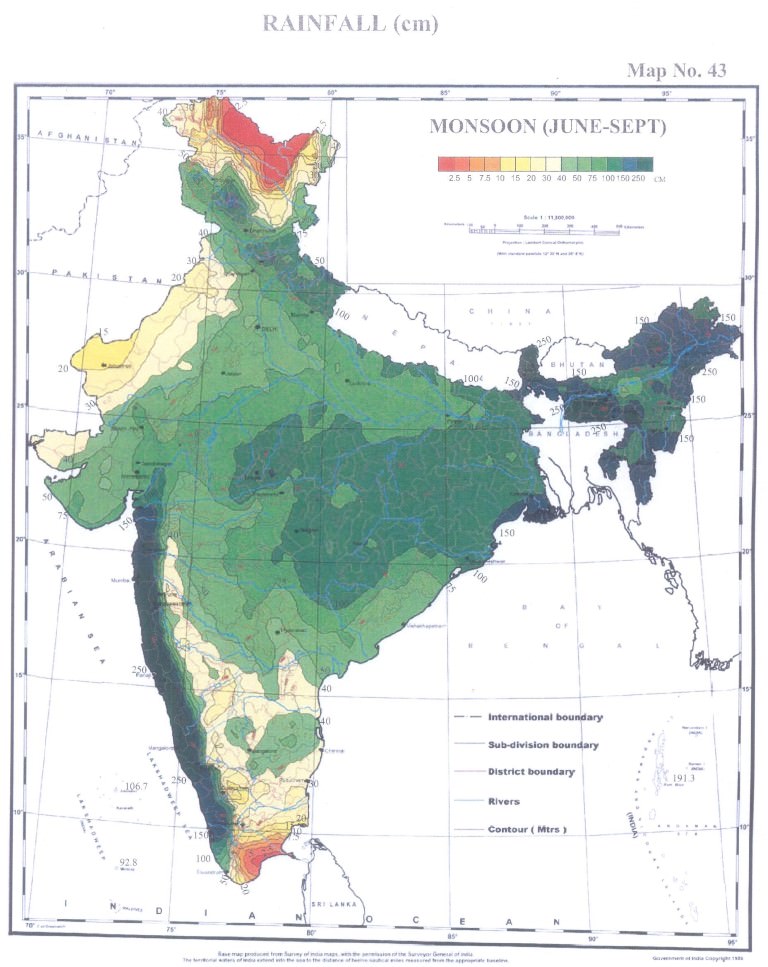
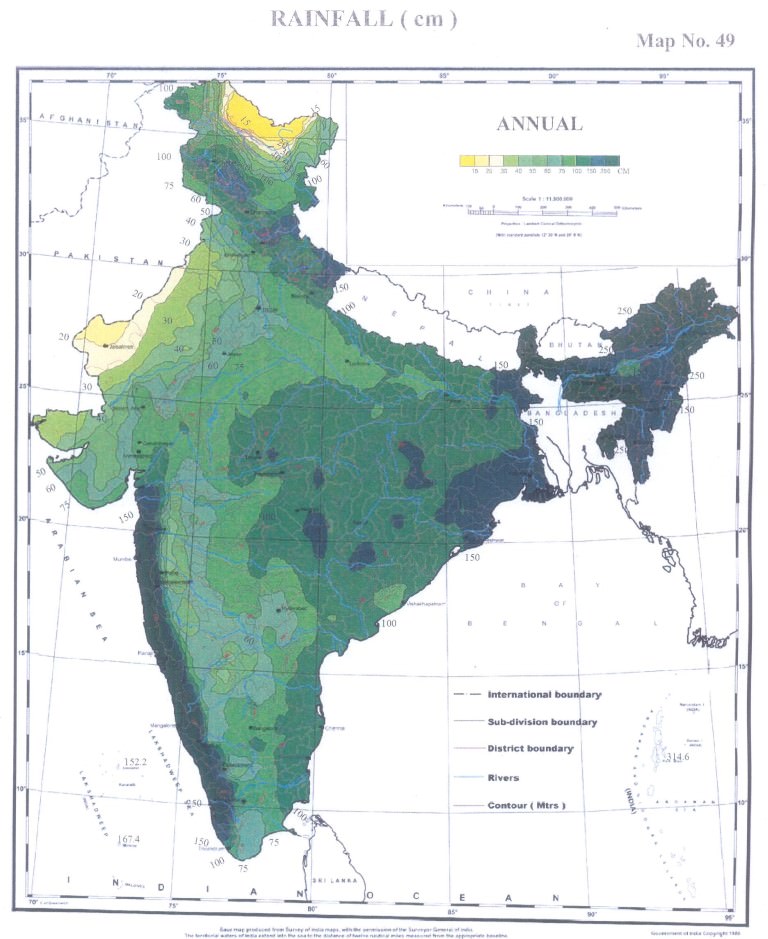
South West Monsoons – Arabian Sea branch and Bay of Bengal branch
- Monsoon winds beyond south Kerala progress in the form of two branches viz. the Arabian Sea branch and the Bay of Bengal branch.
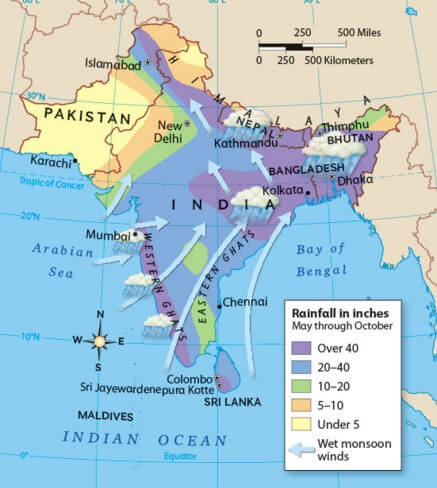
- The Arabian Sea branch gradually advances northwards. It reaches Mumbai by 10th June.
- The Bay of Bengal branch spreads rather rapidly over most of Assam. The normal date of its arrival at Kolkata is 7th June.
- On reaching the foothills of the Himalayas the Bay branch is deflected westward by the Himalayan barrier and it advances up the Gangetic plain.
- The two branches merge with each other mostly around Delhi to form a single current.
- Both the branches reach Delhi more or less at the same time.
- The combined current gradually extends to west Uttar Pradesh, Haryana, Punjab, Rajasthan and finally to Himachal Pradesh and Kashmir.
- By the end of June the monsoon is usually established over most parts of the country.
- By mid-July, the monsoon extends into Kashmir and the remaining parts of the country.
- By this time it reaches Kashmir, it has shed most of its moisture.
- Arabian Sea branch of the monsoon is much powerful than the Bay of Bengal branch for reasons:
- The Arabian Sea is larger than the Bay of Bengal, and
- the entire Arabian Sea current advances towards India, whereas only a part of the Bay of Bengal current enters India, the remainder proceeding to Myanmar, Thailand and Malaysia.
The Arabian Sea branch of the southwest monsoons is divided into three distinct streams on arriving in the mainland of India.
- The first stream strikes the west coast of India and gives extremely heavy rainfall of over 250 cm. It strike perpendicular to Western Ghats causing plentiful Orographic Rainfall [400 to 500 cm annual rainfall on the windward side].
- Rainfall is drastically reduced to about 30-50 cm on the leeward side of the crest.
- There is a narrow belt of marked aridity on the immediate leeward side of the Western Ghats. But once it is passed, the air starts rising again and the amount of rainfall increases further east.
- The second stream enters Narmada—Tapi troughs
(narrow rift valley) and reaches central India. It does not cause much rain near the coast due to the absence of major orographic obstacle across the rift. Some parts of central India receive rainfall from this stream (Ex: Nagpur). - The third stream moves parallel to the Aravali Range without causing much rainfall. Consequently the whole of Rajasthan is a desert area.
- However, some orographic effect is occurs on the south-eastern edge of the Aravali Range. Mt. Abu gets about 170 cm rainfall while the surrounding plains have only 60 to 80 cm rainfall.
The Bay of Bengal Branch of the southwest monsoon is divided into two distinct streams.
- The first stream crosses the Ganga-Brahmaputra delta and reaches Meghalaya. Here that the orographic effect results in intense rainfall. Cherrapunji receives an annual rainfall of 1,102 cm, major portion of which occurs from June to August.
- Mawsynram (present champion) located at 1,329 m above sea level just 16 km to the west of Cherrapunji (X champion) records higher annual rainfall of 1,221 cm.
- Both the stations are located on the southern slopes of the Khasi hills at the northern end of a deep valley running from south to north.
- The second stream of the Bay of Bengal branch moves along Himalayan foothills as they are deflected to the west by the Himalaya and brings widespread rainfall to Ganga plain.
- The rainfall by this stream is characterized by a steady decline as we move from east to west up the plain. [Previous Prelims Question]
- The Tamil Nadu coast remains relatively dry during the south-west monsoon period because of
- rain shadow effect of the Arabian Sea current and
- Bay of Bengal current which flows parallel to the coast.
Break in the South West Monsoons
- During the Monsoon season, there are periods when the Monsoon trough shifts to the foothills of Himalayas, which leads to sharp decrease in rainfall over most parts of the country but increase along the Himalayas and parts of Northeast India and Southern Peninsula.
- During July and August, there are certain periods when the monsoons become weak. Rainfall practically ceases over the country outside the Himalayan belt and southeast peninsula. This is known as break in the monsoon.
- Breaks are likely to occur during the second week of August and last for a week.
- The breaks are believed to be brought about by the northward shifting of the monsoon trough (minimum low pressure cell in ITCZ). The axis of the trough lies at the foothills of the Himalayas during the break period.
The monsoon trough is a portion of the Intertropical Convergence Zone as depicted by a line on a weather map showing the locations of minimum sea level pressure, and as such, is a convergence zone between the wind patterns of the southern and northern hemispheres.
- During the break period, heavy rainfall occurs over the sub-Himalayan regions and the southern slopes of the Himalayas.
- On an average one or two breaks do occur during the rainy season. 85 out of 100 years there is a break in the monsoons.
Depressions in South West Monsoon Season
- A major part of the South West Monsoon rainfall is generated by depressions [intense low pressure] originating in the Arabian Sea and Bay of Bengal. Some depressions develop over land also.
- About 3-4 depressions are formed per month from June to September.
- Almost all of them are sucked inward through the deltas of great rivers [They need moisture to be alive], the Ganga, the Mahanadi, the Godavari, the Krishna and the Cauvery and cause heavy rain in these areas.
- The location of depressions strongly coincide with the latitudinal position of ITCZ.
- Most of the depression originate to the west of 90⁰ E in Bay of Bengal and move in north-west direction.
- In the Arabian Sea in June-July, the depressions move either in north-west or in northerly direction and may affect west Gujarat or Maharashtra.
- Storms during August and September are rare and are formed close to Maharashtra-Gujarat coast.
- Most of the rainfall in central and northern parts of the country is caused by these depressions.
- The absence of depressions or a change in their tracks result in deficit or no rain.
Advance and Withdrawal of South West Monsoons
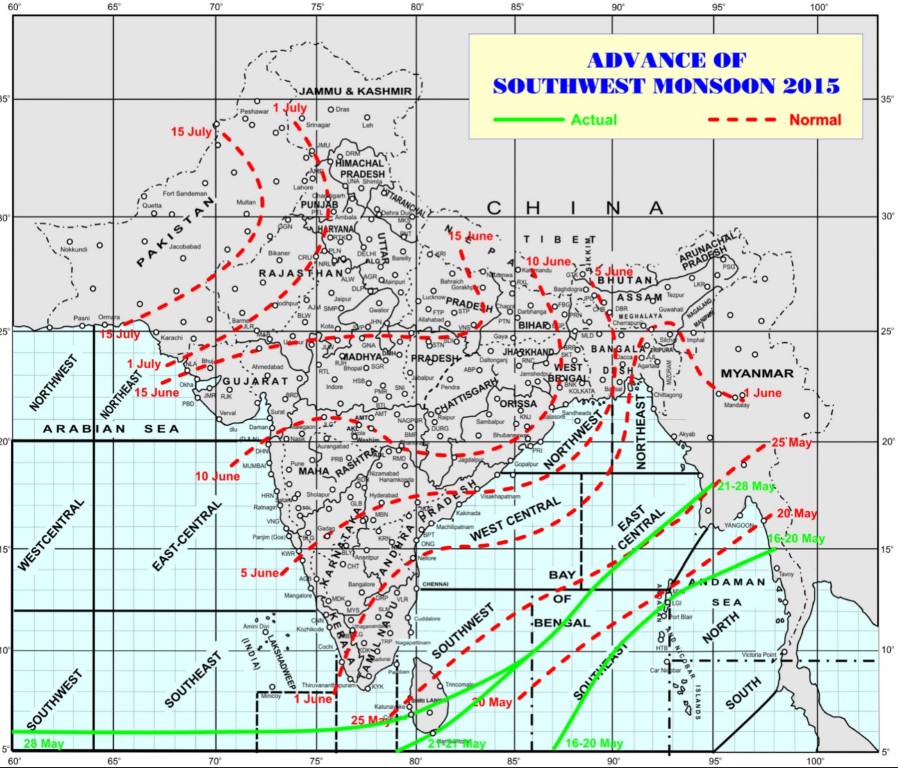
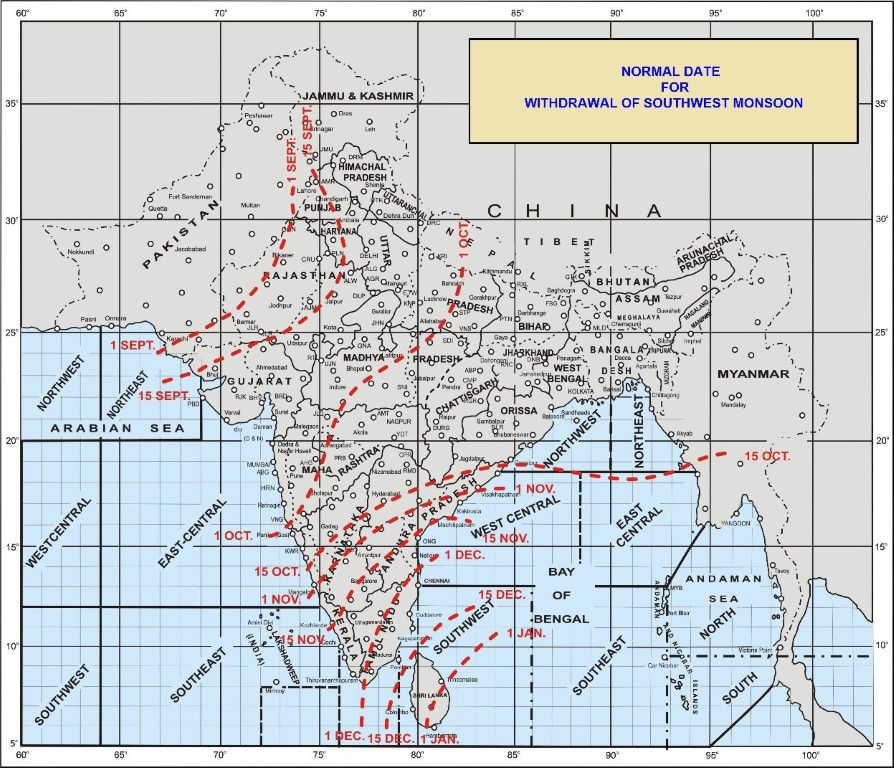
Chief Characteristics of South West Monsoon Rainfall
- Major part of monsoon rains are received between June and September.
- Monsoonal rainfall is largely governed by relief and is orographic in its mode.
- The amount of rainfall decreases with increasing distance from the sea.
- The rainless interval during south west monsoon season is known as ‘breaks’. The breaks in rainfall are related to tropical cyclones which originate in the Bay of Bengal.
- There are large scale spatial variations in the distribution of rainfall.
- Monsoons often fail to keep date. Sometimes the monsoons withdraw before the scheduled time causing considerable damage to the crops
.
